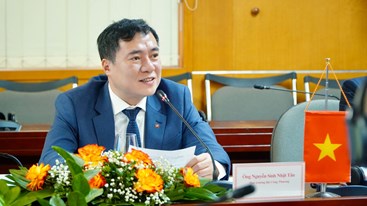Sunday, 28/04/2024 | 10:20 GMT+7
Along with urban growth, the demand for use of energy in urban areas has increased rapidly, especially in big cities such as Hanoi, Hai Phong, Ho Chi Minh City, Da Nang and Nha Trang. In such circumstances, using solar energy is considered to be a solution that will help reduce energy consumption in urban areas and prevent climate change. This solution was discussed at a workshop themed 'Climate change and sustainable urban development in Vietnam' that was held recently in Hanoi.
The results of research done by a team from the Leibniz Institute of Ecological and Regional Development (Germany) show that each year Ho Chi Minh City alone consumes about one fifth of the country's total energy consumption. In recent years, urban development and electricity shortage required the Vietnamese Government to promote energy efficiency and conservation along with making efforts to find alternative energy resources. Nguyen Xuan Thinh from the Leibniz Institute of Ecological and Regional Development said, "Some renewable energy resources, especially solar energy, wind power and biogas, are of great potential and can be utilized in Vietnamese cities."

Vietnam is located near to the equator and the average sunshine hours in most provinces of Vietnam are 2,000 hours a year. The potential of solar energy in big cities is 4.08-5.15 kWh per sq.m per day. This means natural conditions in Vietnam are favorable for solar energy development and utilization. Solar energy is a reliable type of energy that can be utilized to generate electricity for use during peak hours. Solar energy systems can be designed to provide electricity to a building or a whole township. Using this type of energy, the world can save 2-3 billion tonnes of coal each year. Ngo Thi To Nhien, an official from the National Center for Technological Progress under the Ministry of Science and Technology, said, "Solar energy technologies are inexpensive and solar energy is a potential type of energy that can be utilized in big cities."
Solar energy is being used mostly with solar energy gathering devices, solar batteries and solar heating panels. Solar energy gathering devices are mirrors that are used to gather sunlight and generate heat. The heat will be used to create steam for turbines to generate electricity. Building a solar power plant requires less investment capital than building a photoelectric plant. Moreover, solar power plants can generate electricity for use on a large scale. They can operate most efficiently during sunshine hours to meet high demand. The amount of heat gathered by solar mirrors can be reserved and therefore the output of solar power plants is more stable than that of photo-electric plants. Solar power plants can be operated at a lower cost and more safely in comparison with power plants using fossil energy.
Solar batteries can be used to turn photo energy of sunlight into electricity. A solution that many other countries in the world are taking is connecting solar batteries to the power grid. Solar batteries can be installed on the roofs, banisters and the earth surface or into public lighting systems, traffic light and traffic signal systems.
The solar heat technology is being used widely in many cities in the world, mostly in China, European countries, the US and Canada. In Vietnam, this technology is applied to manufacture solar water heaters and solar air-conditioners. To promote the use of solar energy, the Vietnamese Government has launched a program under which consumers will be offered a subsidy of VND1 million when buying a Thai Duong Nang solar water heater manufactured by the Son Ha Group.
Solar energy resources in Vietnam are of great potential. However, most types of solar energy equipment in Vietnam remain expensive. Moreover, Vietnam still lacks appropriate policies to develop renewable energy resources in general and solar energy in particular. Offering consumers a subsidy to buy solar energy equipment is considered to be a good solution to promote the development and utilization of this type of renewable energy.
By Phuong Lan

.png?w=367&h=206&mode=crop)






.jpg?w=367&h=206&mode=crop) Energy efficiency and conservation usage is an important aspect of the national energy development strategy
05/03/2024
Energy efficiency and conservation usage is an important aspect of the national energy development strategy
05/03/2024
 Challenges and Opportunities to promote energy efficiency market in Vietnam
Challenges and Opportunities to promote energy efficiency market in Vietnam
 The Ministry of Industry and Trade requests government agencies to coordinate in organizing Earth Hour 2024
The Ministry of Industry and Trade requests government agencies to coordinate in organizing Earth Hour 2024
 Consultation on Energy Efficiency Boiler Catalogue and Wood Drying Guideline
Consultation on Energy Efficiency Boiler Catalogue and Wood Drying Guideline
 Son Ha Co., Ltd, applies energy efficiency and conservation measures
Son Ha Co., Ltd, applies energy efficiency and conservation measures
.png?w=367&h=206&mode=crop) Request for expression of interest - C2.1.13: Capacity Building on energy efficiency policies development
Request for expression of interest - C2.1.13: Capacity Building on energy efficiency policies development
 Phuc Kien Co., Ltd., is effectively implementing energy-saving measures
Phuc Kien Co., Ltd., is effectively implementing energy-saving measures
 Request for expression of interest - C2.1.12: Independent monitoring of safeguards implementation
Request for expression of interest - C2.1.12: Independent monitoring of safeguards implementation